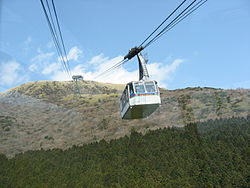This article needs additional citations for verification .(June 2025) |
The list of aerial lifts in Japan lists aerial lifts in the nation.
Contents
- Hokkaidō
- Tōhoku region
- Aomori Prefecture
- Iwate Prefecture
- Akita Prefecture
- Miyagi Prefecture
- Yamagata Prefecture
- Fukushima Prefecture
- Kantō region
- Gunma Prefecture
- Tochigi Prefecture
- Ibaraki Prefecture
- Chiba Prefecture
- Saitama Prefecture
- Kanagawa Prefecture
- Chūbu region
- Shizuoka Prefecture
- Yamanashi Prefecture
- Nagano Prefecture
- Niigata Prefecture
- Ishikawa Prefecture
- Toyama Prefecture
- Gifu Prefecture
- Mie Prefecture
- Kansai region
- Shiga Prefecture
- Nara Prefecture
- Kyōto Prefecture
- Ōsaka Prefecture
- Hyōgo Prefecture
- Chūgoku region
- Hiroshima Prefecture
- Yamaguchi Prefecture
- Shimane Prefecture
- Shikoku region
- Kagawa Prefecture
- Tokushima Prefecture
- Ehime Prefecture
- Kyūshū region
- Ōita Prefecture
- Nagasaki Prefecture
- Kumamoto Prefecture
- See also
- References
- External links
In Japan, aerial lift, or "ropeway" (索道, sakudō), includes means of transport such as aerial tramway, funitel, gondola lift, funifor, as well as chairlift. All of them are legally considered as a sort of railway. Chairlift is officially called "special ropeway" (特殊索道, tokushu sakudō), while colloquially called "lift" (リフト, rifuto). Other aerial lifts are officially called "normal ropeway" (普通索道, futsū sakudō), or colloquially "ropeway" (ロープウェイ or ロープウェー, rōpuwei or rōpuwē). Technical names exist for each "normal ropeway", such as "double single-cabled automatic loop normal ropeway" (複式単線自動循環式普通索道, fukushiki tansen jidō junkan-shiki futsū sakudō) for funitel gondola lifts, but those names are hardly used outside authorities; most people don't distinguish them. Number of Japanese "normal ropeways" listed here are as follows.
| Systems | Full year operational | Seasonal | Total |
|---|---|---|---|
| Gondola lifts | 62 | 32 | 94 |
| Aerial tramways | 68 | 4 | 72 |
| Funitel gondola lifts | 3 | 0 | 3 |
| Funitel aerial tramways | 1 | 0 | 1 |
| Total | 134 | 36 | 170 |
It is also notable that the word "cable car" (ケーブルカー, kēburukā) does not refer to aerial lifts in Japan, but to cable railways, such as cable cars proper or funiculars. (However, Japan currently does not have any cable cars proper, having only funiculars.)
This article only lists "normal ropeways"; in other words, aerial lifts excluding chairlifts. Names might be tentative.
- Italicized name: Aerial lifts that operate seasonal, mostly in ski resorts.
- T: Aerial tramways. (Those without T are gondola lifts.)
- F: Funitels.












